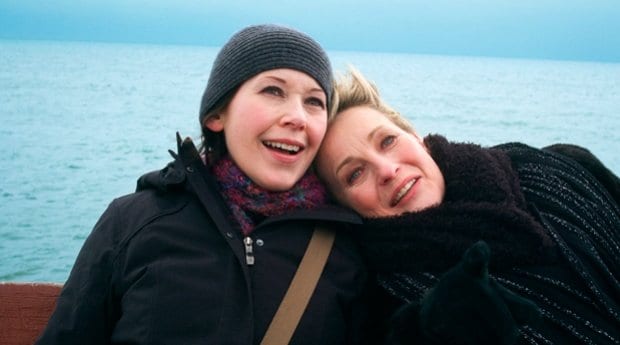Autumn is a season of togetherness; maybe it’s the chill in the air that reminds us of the impending winter months or a desire to share the yearly harvest with our friends and neighbours. Whatever the reason, we come together in the fall, sharing experiences and enjoying each other’s company.
But we also live in a world where we are increasingly apart from each other and where connections are made digitally across great distances. Ironically, the technology that allows us to communicate with each other can also be isolating, and some experiences that were once communal now happen on an individual basis.
This can be especially true for film. Seeing a movie used to mean sitting with others and munching popcorn in the dark; it’s now a more solitary activity, as theatres close and more of us choose to watch films on our personal devices. But there’s still some magic in the darkened, flickering cave of the movie theatre, and the organizers of Inside Out, Canada’s largest LGBT film festival, are trying to hold onto it.
Inside Out has taken place in Ottawa since 2007 and Toronto since 1991. “Basically, a group of community activists and artists got together in, like, 1990 and saw that there was a kind of gap in opportunities for the community to come together and watch queer film in … a queer environment,” says executive director Scott Ferguson, who has been with Inside Out since 2001.
The festival was entirely volunteer-run at first, but as the organization grew and began to attract wider support and sponsorship, it was able to bring on paid employees. Now, Inside Out presents an 11-day festival in Toronto and a four-day festival in Ottawa, in addition to offering workshops, educational programs and filmmaker support.
To pull off festivals in two cities is a year-round commitment. Director of programming Andrew Murphy says the year begins in January with “deep research mode.” What follows is a period of fundraising and grant writing to prepare for the Toronto festival in May. After that wraps up, the team gets to work on the Ottawa festival, and by July, the planning is well underway. Inside Out Ottawa takes place in October, then submissions for the Toronto festival open and the process starts all over again.
It was former director of programming Jason St-Laurent, an Ottawa native, who convinced the Toronto team that it was time to bring the festival here in 2007.
“After my first festival in Toronto, I realized the sort of significant impact that the festival had on the community there,” he says. “Other than Pride, there’s not much in the city that brings the queer community together in that way, and to do it with a cultural event is even more significant, in my view, so I felt that Inside Out could have an impact in Ottawa as well.”
St-Laurent says that in the festival’s early days in Ottawa, the city’s lesbian community was its key supporter. “That was the core of our audience at that time, at the very beginning,” he says. “I think the festival wouldn’t be where it [is] today without the lesbian community here.”
Now the curator at SAW Gallery, St-Laurent continues to be an ally of Inside Out and has offered up the gallery over the years as a screening venue and an office space. “The challenge for Inside Out, I think, is to try to boil down what’s being made internationally into this kind of compact festival,” he says. “What I like about the festival here is that it really boils it down to the best of queer film and video around the planet.”
Deciding which films will screen in Ottawa has a lot to do with the timing of theatrical releases and other festivals, director of programming Andrew Murphy says. “It’s always challenging, and the window gets smaller and smaller, so really we just want the best and most well-rounded program possible.” If films that screened in Toronto in May have been released theatrically or on iTunes before the Ottawa festival in October, it can mean going back to the drawing board. “It’s a combination of what we think will work with the Ottawa audience and also what are some of the festival favourites through the year, which is the benefit of having Ottawa in the fall.”
This year’s program includes 13 features and 25 shorts, representing more than a dozen countries. Murphy says including Canadian content is very important to Inside Out, pointing to festival opener Tru Love, a story about a lesbian May-December romance co-directed by and starring Canadian Shauna MacDonald, who will be in attendance at the screening.
Former festival coordinator Layla Cameron says politically charged films often go over best in Ottawa, a city with a lively activist community. “I think Inside Out shows a lot of cinema that needs to be seen,” she says. “Being able to show documentaries about social-justice issues both at home and abroad and how they affect different queer communities is so important and so valuable, and Ottawa definitely does have an audience for that.
“Film is such a great way to reach out to an audience and encourage action after the film,” she says. “I mean, film is one of the only art forms where people are leaving a performance and you hear them talking about what they want to do now after what they’ve seen. Inside Out, I think, provides that platform.”
St-Laurent agrees. “Think of all the conversations that happen after films,” he says. “I’ve seen people debate in the lobby after a film comes out, and depending on the film, sometimes it’s a political debate, sometimes it’s an aesthetic debate. It brings about a certain discourse that nothing else can do.”
Inside Out also brings together the community to watch films they would otherwise be more likely to stream in private. “There’s a lot of queer work being produced out there and not a lot of opportunity to show it in Ottawa,” Murphy says. He points to the ByTowne Cinema (which is where most of the Inside Out films will be shown) as an example of a theatre that screens queer films as part of its regular programming. But Inside Out remains unique in bringing a dedicated four-day roster of films to Ottawa.
For festival volunteers, Inside Out is a chance to become involved in their community and see queer cinema free. Loresa Novy, a past festival coordinator, says volunteers are a crucial link between the organizers in Toronto and the Ottawa community. She says that in her time as coordinator, she worked with many college students, LGBT community members and allies, and even retirees.
It is in bringing together these different and disparate groups that film festivals work their most pervasive magic. Laughing and crying in the dark with strangers and popcorn has to be good for the soul, and as St-Laurent notes, it’s a way of hearing the voices of a community with a long, complex history and an uncertain future. “I think in terms of keeping our history alive, Inside Out is very key to that.”
Inside Out
Ottawa
Thurs, Oct 23–Sun, Oct 26
insideout.ca/ottawafestival


 Why you can trust Xtra
Why you can trust Xtra


